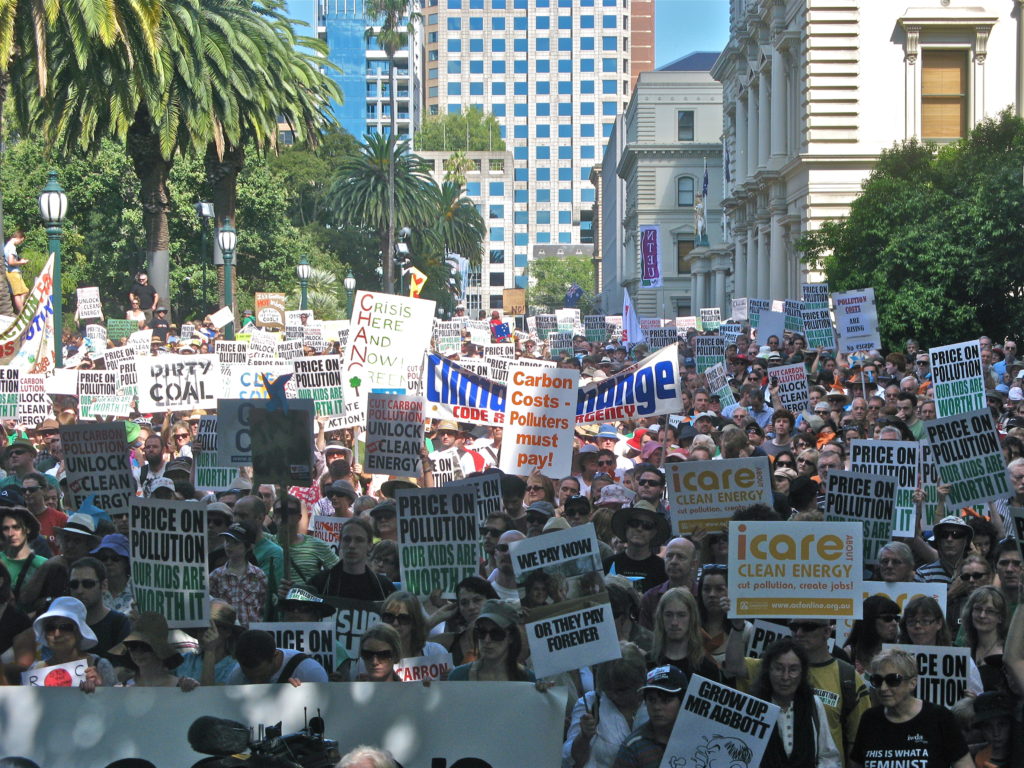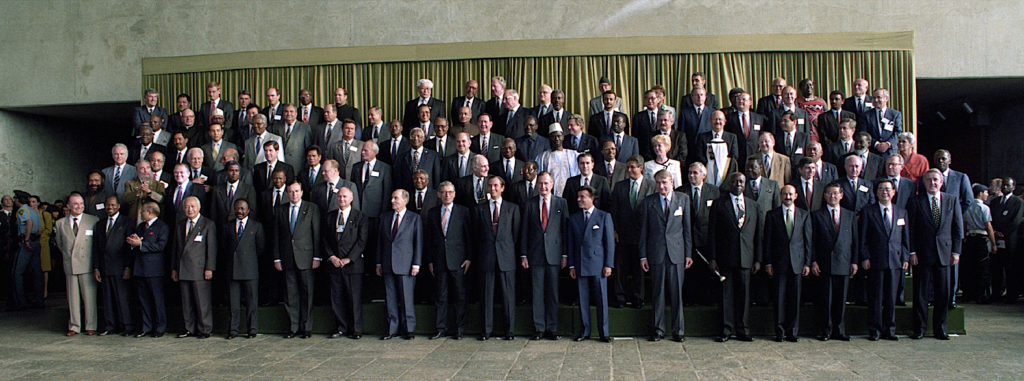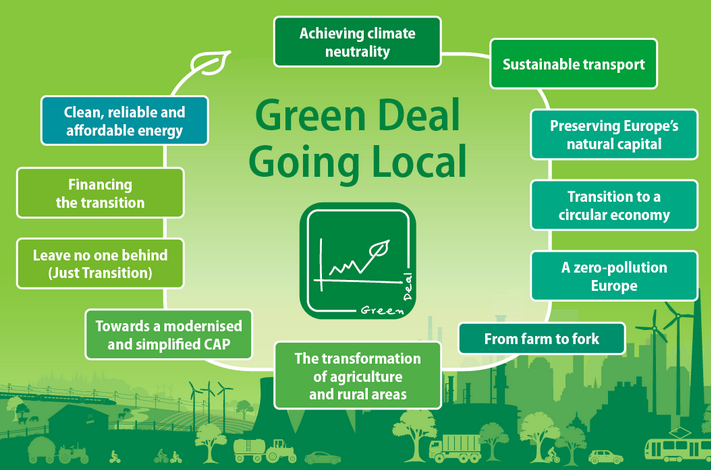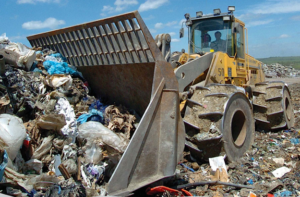Sustainable economy © European Union
Every day, we are struck by the dramatic consequences of climate change in faraway territories as well as in countries closer to us. We are stunned by the catastrophic images that reach us from the rest of the world.
Fires, heat waves, droughts, floods, cyclones, melting ice, pandemics, displacement of populations… Climate change has become our day to day reality, from Europe to the Sahel in Africa, from California to Bangladesh. And we are only at 1.1 degrees of average warming! According to the UN, this will mean 150 million victims per year by 2030.
In December 2019, the European Commission proposed a Green Deal for Europe and its citizens. It reiterates the Commission’s commitment to address climate and environmental challenges as a major mission of our generation.
Year after year, the atmosphere is warming and the climate is changing. Of the estimated eight million species on our planet, one million are already at risk of extinction. Forests and oceans continue to be polluted and destroyed. On March 10, 2021 the European Parliament voted on a resolution on the future Carbon Border Adjustment Mechanism (CBAM). The instrument, which is scheduled to come into force in 2023, should enable the European Union to impose its environmental standards on foreign companies exporting to its territory.
In concrete terms, this mechanism would define a threshold of greenhouse gas emissions above which an economic activity would be considered too polluting. All goods imported into the EU whose production has a carbon footprint above this threshold would then be subject to an additional tax.

In order to reduce its carbon footprint, the European Union is currently acting mainly on its own territory. But not everything depends on the greenhouse gas emissions of the single market alone. The EU is a free-trading entity with a largely globalised economy. It has imported over 2,100 billion euros worth of goods in 2019; this intense trading is almost the equivalent of France’s GDP and represents 20% of Europe’s greenhouse gas emissions, whose carbon footprint increases year by year. Faced with the increasingly ambitious environmental regulations imposed in the EU, multinational companies established in Europe may be tempted to relocate their activities so as to pollute “freely” elsewhere. This is precisely what The Greens in the European Parliament are striving to avoid.
The carbon adjustment mechanism thus aims to reduce the carbon footprint of companies exporting to the EU by limiting carbon “leakage”. In other words, to prevent Europe from forcing its industrial fabric to comply with demanding standards on its territory, while at the same time importing goods whose production accelerates global warming.
MORE AND MORE CO2 THROUGH PRODUCTS AND SERVICES IMPORTED BY THE EU
The Paris Agreement adopted in December 2015 had initiated the first positive move forward by limiting global warming to well below 2, preferably to 1.5 degrees Celsius, compared to pre-industrial levels. Unfortunately, all the Member States have not yet begun to fully implement the measures. Current climate policies are leading us towards a warming of 3 to 4°C, or even 5 or 6 according to the most pessimistic scenarios. For future generations, this could bring about irreversible damage and lead to an unknown world of chaos.

Ursula von der Leyen, the President of the European Commission has made the Green Pact for Europe the cornerstone of her mandate. It is a Pact with a very ambitious goal: to achieve climate neutrality by 2050. She has in fact referred to it as “Europe’s man on the moon moment”, adding that the first package of proposals aims to reconcile “our economy with our planet”.
In her first State of the Union speech in September 2020, Ursula von der Leyen said :
“We have more proof that what is good for the climate is good for business and is good for us all”.
And she added, after announcing an increase in the existing 2030 emission-reduction target, from 40 percent to 55 percent, compared to 1990 levels :
“There is no more urgent need for acceleration than when it comes to the future of our fragile planet”.
In concrete terms, this means that the Union’s greenhouse gas emissions must be low enough to be absorbed by natural carbon ‘sinks’ – such as the oceans and forests – and technological ones, which can capture them artificially. On March 10, 2021 MEPs voted on a non-binding resolution on the Carbon Border Adjustment Mechanism. Armed with this text that allows MEPs to take a position before the actual legislative process, they hope to have some political influence on the direction that the mechanism will take. In June 2021, the project will be the subject of a legislative proposal by the European Commission before the three-way dialogue and negotiations begin in 2022.
Implementation of the measures are expected to begin on 1 January 2023, in accordance with the timetable of the recovery plan adopted by European leaders in July 2020.
AN OLD IDEA BUT A NEW RESOURCE FOR THE EU
The idea of a carbon border adjustment mechanism is not new. It was first proposed by the EU in 1991, one year before the Rio Earth Summit.

At the time, many Member States dismissed the idea as untenable. But it returned to the European Commission’s agenda in late 2019.
This would encourage exporting companies to turn to less polluting technologies and would consequently allow the EU, by reducing its greenhouse gas emissions to limit its “external” climate balance. To mitigate the economic consequences of the Covid-19 pandemic, the Member States adopted in July 2020, a 750 billion euro recovery plan financed by borrowing. The financial package around this operation specifies that the repayment of this loan shall be made with the money released through new resources.
Within this framework, the EU institutions have agreed on a legally binding schedule. The border carbon adjustment mechanism should be in place by January 1, 2023 and according to the Commission’s estimates, it could bring in between 4 and 14 billion euros per year for the EU. In addition to its environmental impact, the project is therefore part of an economic recovery strategy.
It is also part of another dynamic: the autonomy of the European budget. Three quarters of the budget is in fact funded by national contributions from the Member States, which have a decisive financial leverage.
By creating new own resources, the EU gains independence from this financial windfall. However, in its resolution, the European Parliament believes that the money generated by this mechanism should also be redistributed to the less advanced countries to enable them to develop a more environmentally friendly economy.
THE CONSEQUENCES FOR THE EU
Although it has been under study for several decades, this carbon adjustment mechanism at the borders is nonetheless very innovative for the Union. It has even been compared to an “ideological revolution”, by some members of the EPP group in the European Parliament.

The young French MEP François-Xavier Bellamy for instance, believes that the EU is developing a “new relationship with globalisation” with this mechanism:
“For a long time, the European core principle was based on free trade and on the conviction that the only mission of the EU was to abolish barriers to bring the cheapest possible product to the final consumer (…). Today, we see a break in this ideology because with this mechanism, we are putting in place an environmental and industrial strategy that will allow us to move towards fair competition between European and global companies.”
Beyond this paradigm shift, the carbon adjustment mechanism at borders marks a turning point in European industrial and trade policy. The EU, which preaches “the end of a naïve Europe” in the words of Commission President Ursula von der Leyen, aims to create the conditions for fair competition with companies from third countries. By introducing this mechanism, it would place companies from all over the world on an equal footing for access to the European market. In other words, this mechanism would fully comply with World Trade Organisation rules and guidelines.
At any rate, it is in this spirit that MEPs would like this mechanism to be applied.
The aim is certainly not to put in place protectionist measures and disadvantage companies from third countries.
THE FORM TAKEN BY THE MECHANISM
Although the European Commission’s detailed proposal will not be known until next June, several points are already being debated.
The first concerns the form that this mechanism should take. Three solutions are being considered: consumer taxes, a customs tax or the extension of the carbon emissions trading scheme (ETS) to companies in third countries, which currently only concerns companies based in Europe. The European Union has set up a carbon market, which allocates carbon emission quotas to companies. If these quotas are exceeded, they must pay a surcharge, defined by the market (25 euros per ton of carbon at the end of 2019). This solution, favoured in the European Parliament’s resolution, would guarantee fair competition with European companies.

Conversely, a border carbon tax would be of a fixed amount and therefore potentially higher or lower than the European carbon market price, risking the creation of new inequalities for competition.
The European Parliament’s resolution also opposes the proposed consumption tax, which “would be tantamount to making Europeans pay the cost of the ecological transition,” argues Pascal Canfin, Chairman of the European Parliament’s Environment Committee.
If it were to be extended to companies in third countries, the ETS would have to be reformed. Currently, the system grants, in more or less large proportions, free carbon emission allowances to companies operating in sectors under pressure due to the economic situation and competition. “For example, 80% of the carbon emission allowances allocated to the European aviation sector are free,” says Pascal Canfin.

These exceptions which are harshly criticized by the European Court of Auditors, could therefore be lifted to achieve the fairest possible competition.
INDICATORS AND MEASUREMENT TOOLS
If the option of extending the carbon market to third countries is retained, another crucial question must be answered : what is threshold above which companies will be deemed too polluting and will have to buy quotas ?
This threshold can be calculated in two ways: either by taking into account the carbon balance of exports to Europe by companies in third countries, or by taking into account their carbon balance as a whole.
In both cases, the mechanism will run into a major problem.
It requires the establishment of a database listing the carbon footprint of companies on whose activity the calculation can be made. It also implies being able to “trace” each good exported to Europe in order to assess the responsibility of each link in the production chain (the company that extracts the raw materials, the one that transforms them, the one that exports them, as well as all the different subcontractors involved).

This is nevertheless the position defended by the European Parliament.
There is also a plan on the negotiating table to add an exceptional provision regarding companies in countries with the least developed economies. Pascal Canfin sums up its purpose as follows:
“It would be questionable to finance part of our recovery plan with money generated by the carbon cost of exports from less developed countries. It seems more equitable to us to redistribute part of this financial windfall to these countries so that they can finance their own ecological transition”.


THE SCOPE OF APPLICATION
Although its scope has yet to be defined by the European Commission, the mechanism could concern the vast majority of industrial activities if it were to extend the European carbon market.
If the objective is to progressively integrate all products that have an impact on the climate, the Commission should start with the most emitting industrial productions, namely cement, steel, aluminium, chemicals and fertilizers as well as electricity. These alone account for 94% of industrial emissions.

Other sectors, however, are subject to debate; in its resolution, the European Parliament also advocates the inclusion of the maritime sector and wood burning for example, in the carbon adjustment mechanism.
“These measures are important and reasonable,” says Richard Fuchs from the Institute of Meteorology and Climate Research (IMK) in Garmisch-Partenkirchen, Germany. “But it will be also necessary to specify foreign trade goals. Otherwise, we will only outsource the problem and continue to damage our planet.”
In order to maintain social cohesion, the European Commission must ensure that the burden of this necessary transformation does not fall on ordinary wage earners, or on the most economically fragile among the population. With the revenues obtained, the climate transition in Europe and in the poorest countries that are most affected by climate change can be financed.
European citizens expect the European Union to act with more determination and ambition for the climate. And that it stops being “naive” or cynical about its trade policy, too often ignoring the social, environmental and industrial costs of the free trade agreements it signs.
The border carbon adjustment mechanism is a tremendous opportunity to reconcile climate, territories, industry, employment, resilience, sovereignty and relocation.
In this respect, it constitutes a major political and democratic test for the Union.
The European Parliament must show the way!

